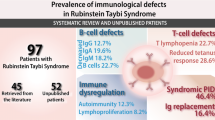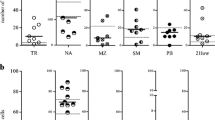Abstract
Hyper-IgM syndromes are characterized by normal or elevated serum IgM levels with the absence or reduced levels of other immunoglobulins. There are some patients with defective class-switch recombination (CSR) who do not have CD40L, CD40, AID, and UNG defects. The aim of this study is to determine the B-cell functions of patients with Hyper-IgM type 4 phenotype. Ten patients (seven males and three females) 84.2 ± 16.5 months of age with initial low serum IgG and IgA and high or normal IgM levels were included. Clinically, 50% had recurrent upper respiratory tract, 10% urinary tract, 10% lower respiratory tract infections, and 30% had mixed type infections. Lymphoid hyperplasia, overt autoimmune manifestations, or malignancy was not noted. Seven of 10 patients were studied twice; at the age of 34.2 ± 13.7 and at 86.6 ± 12.3 months. Absolute lymphocyte counts and lymphocyte subsets were normal in all cases. All of them had normal expression of CD40 on B cells and CD40L on activated T cells for males. At first examination, all patients had normal in vitro sCD40L+rIL-4-induced B cell proliferation response and somatic hypermutation but CSR towards IgE was absent. AID and UNG genes did not show any abnormalities. All showed improvement in both clinical findings and Ig levels during the follow-up period of 55.8 ± 14.8 months. Ages for normalization of IgG and IgA were 68.2 ± 8.7 and 70.2 ± 21.6 months, respectively. During the second evaluation: In vitro sCD40L+rIL-4-induced B-cell proliferation was normal in all cases, whereas CSR was still abnormal in five of eight patients. Two of the patients had an increase in in vitro CSR response but still low IgG2 subclass levels. Three patients with initially absent in vitro CSR response also normalized. Conclusion: Clinical manifestations and immunoglobulin levels of the patients with Hyper-IgM type 4 phenotype recovered in late childhood at about 6 years of age. There was a transient CSR defect which was not observed in cases with transient hypogammaglobulinemia of infancy. Detection of a non-AID or non-UNG associated CSR defect in infancy should be confirmed later on since spontaneous recovery may occur.

Similar content being viewed by others
References
Conley ME, Cooper MD (1981) Immature IgA B cells in IgA-deficient patients. N Engl J Med 305:495–497
Cunningham-Rundles C, Bodian C (1999) Common variable immunodeficiency: clinical and immunological features of 248 patients. Clin Immunol 92:34–48
Davies EG, Thrasher AJ (2010) Update on the hyper immunoglobulin M syndromes. Br J Haematol 149:167–180
Durandy A, Revy P, Fischer A (2004) Human models of inherited immunoglobulin class switch recombination and somatic hypermutation defects (Hyper-IgM syndromes). Adv Immunol 82:295–330
Durandy A, Revy P, Imai K, Fischer A (2005) Hyper-immunoglobulin M syndromes caused by intrinsic B-lymphocyte defects. Immunol Rev 203:67–79
Durandy A, Peron S, Fischer A (2006) Hyper-IgM syndromes. Curr Opin Rheumatol 18:369–376
Durandy A, Taubenheim N, Peron S, Fischer A (2007) Pathophysiology of B-cell intrinsic immunoglobulin class switch recombination deficiencies. Adv Immunol 94:275–306
Erdos M, Durandy A, Maródi L (2005) Genetically acquired class-switch recombination defects: the multi-faced Hyper-IgM syndrome. Immunol Lett 97:1–6
Erdos M, Alapi K, Maródi L (2007) Retrospective diagnosis of X-linked hyper-IgM syndrome in a family with multiple deaths of affected males. Haematologica 92:281–282
Erdos M, Garami M, Rákóczi E, Zalatnai A, Steinbach D, Baumann U, Kropshofer G, Tóth B, Maródi L (2008) Neuroendocrine carcinoma associated with X-linked hyper-immunoglobulin M syndrome: report of four cases and review of the literature. Clin Immunol 129:455–461
Etzioni A, Ben-Barak A, Peron S, Durandy A (2007) Ataxia–telangiectasia in twins presenting as autosomal recessive hyper-immunoglobulin M syndrome. Isr Med Assoc J 9:406–407
Geha RS, Notarangelo LD, Casanova JL, Chapel H, Conley ME, Fischer A et al (2007) Primary immunodeficiency diseases: an update from the International Union of Immunological Societies Primary Immunodeficiency Diseases Classification Committee. J Allergy Clin Immunol 120:776–794
Hanson LA, Söderström R, Nilssen DE, Theman K, Björkander J, Söderström T, Karlsson G, Brandtzaeg P (1991) IgG subclass deficiency with or without IgA deficiency. Clin Immunol Immunopathol 61:S70–S77
Ikincioğullari A, Kendirli T, Doğu F, Eğin Y, Reisli I, Cin S, Babacan E (2004) Peripheral blood lymphocyte subsets in healthy Turkish children. Turk J Pediatr 46:125–130
Imai K, Catalan N, Plebani A, Maródi L, Sanal O, Kumaki S, Nagendran V, Wood P, Glastre C, Sarrot-Reynauld F, Hermine O, Forveille M, Revy P, Fischer A, Durandy A (2003) Hyper-IgM syndrome type 4 with a B lymphocyte-intrinsic selective deficiency in Ig class-switch recombination. J Clin Invest 112:136–142
Imai K, Zhu Y, Revy P, Morio T, Mizutani S, Fischer A, Nonoyama S, Durandy A (2005) Analysis of class switch recombination and somatic hypermutation in patients affected with autosomal dominant Hyper-IgM syndrome type 2. Clin Immunol 115:277–285
Jesus AA, Duarte AJ, Oliveira JB (2008) Autoimmunity in Hyper-IgM syndrome. J Clin Immunol 28:S62–S66
Johnson ML, Keeton LG, Zhu ZB, Volanakis JE, Cooper MD, Schroeder HW Jr (1997) Age-related changes in serum immunoglobulins in patients with familial IgA deficiency and common variable immunodeficiency (CVID). Clin Exp Immunol 108:477–483
Karaca NE, Karadeniz C, Aksu G, Kutukculer N (2009) Clinical and laboratory evaluation of periodically monitored Turkish children with IgG subclass deficiencies. Asian Pac J Allergy Immunol 27:43–48
Kracker S, Gardes P, Mazerolles F, Durandy A (2010) Immunoglobulin class switch recombination deficiencies. Clin Immunol 135:193–203
Kutukculer N, Karaca NE, Demircioglu O, Aksu G (2007) Increases in serum immunoglobulins to age-related normal levels in children with IgA and/or IgG subclass deficiency. Pediatr Allergy Immunol 18:167–173
Lanzi G, Ferrari S, Vihinen M, Caraffi S, Kutukculer N, Schiaffonati L, Plebani A, Notarangelo LD, Fra AM, Giliani S (2010) Different molecular behavior of CD40 mutants causing hyper-IgM syndrome. Blood 116:5867–5874
Manz RA, Arce S, Cassese G, Hauser AE, Hiepe F, Radbruch A (2002) Humoral immunity and long-lived plasma cells. Curr Opin Immunol 14:517–521
McGeady SJ (1987) Transient hypogammaglobulinemia of infancy: need to reconsider name and definition. J Pediatr 110:47–50
Mei HE, Yoshida T, Sime W, Hiepe F, Thiele K, Manz RA, Radbruch A, Dörner T (2009) Blood-borne human plasma cells in steady state are derived from mucosal immune responses. Blood 113:2461–2469
Moschese V, Graziani S, Avanzini MA, Carsetti R, Marconi M, La Rocca M, Chini L, Pignata C, Soresina AR, Consolini R, Bossi G, Trizzino A, Martino S, Cardinale F, Bertolini P, Marseglia GL, Zecca M, Di Cesare S, Quinti I, Rondelli R, Pietrogrande MC, Rossi P, Plebani A (2008) A prospective study on children with initial diagnosis of transient hypogammaglobulinemia of infancy: results from the Italian Primary Immunodeficiency Network. Int J Immunopathol Pharmacol 21:343–352
Muehlinghaus G, Cigliano L, Huehn S, Peddinghaus A, Leyendeckers H, Hauser AE, Hiepe F, Radbruch A, Arce S, Manz RA (2005) Regulation of CXCR3 and CXCR4 expression during terminal differentiation of memory B cells into plasma cells. Blood 105:3965–3971
Nonoyama S, Farrington M, Ishida H, Howard M, Ochs HD (1993) Activated B cells from patients with common variable immunodeficiency proliferate and synthesize immunoglobulin. J Clin Invest 92:1282–1287
Notarangelo LD, Lanzi G, Peron S, Durandy A (2006) Defects of class-switch recombination. J Allergy Clin Immunol 117:855–864
Odendahl M, Mei H, Hoyer BF, Jacobi AM, Hansen A, Muehlinghaus G, Berek C, Hiepe F, Manz R, Radbruch A, Dörner T (2005) Generation of migratory antigen-specific plasma blasts and mobilization of resident plasma cells in a secondary immune response. Blood 105:1614–1621
Péron S, Metin A, Gardès P, Alyanakian MA, Sheridan E, Kratz CP, Fischer A, Durandy A (2008) Human PMS2 deficiency is associated with impaired immunoglobulin class switch recombination. J Exp Med 205:2465–2472
Vieira P, Rajewsky K (1988) The half-lives of serum immunoglobulins in adult mice. Eur J Immunol 18:313–316
Acknowledgments
We thank M. Forveille, F. Selz, and M. Durmuscan for their excellent technical assistance.
Conflict of interest
The authors declare that they have no competing interests.
Author information
Authors and Affiliations
Corresponding author
Rights and permissions
About this article
Cite this article
Karaca, N.E., Durandy, A., Gulez, N. et al. Study of patients with Hyper-IgM type IV phenotype who recovered spontaneously during late childhood and review of the literature. Eur J Pediatr 170, 1039–1047 (2011). https://doi.org/10.1007/s00431-011-1400-2
Received:
Accepted:
Published:
Issue Date:
DOI: https://doi.org/10.1007/s00431-011-1400-2




